Effect of Glue Spread on Bonding Strength, Delamination, and Wood Failure of Jabon Wood-Based Cross-Laminated Timber Using Cold-Setting Melamine-Based Adhesive
Abstract
1. Introduction
2. Materials and Methods
2.1. Materials
2.2. Preparation of Melamine-Based Adhesive
2.3. Characterization of Adhesive
2.4. Preparation of CLT
2.5. Evaluation of CLT Properties
2.6. Statistical Analysis
3. Results and Discussion
3.1. Properties of Cold-Setting Melamine-Based Adhesives
3.2. Bonding Strength and Delamination of CLT
4. Conclusions
Author Contributions
Funding
Institutional Review Board Statement
Data Availability Statement
Acknowledgments
Conflicts of Interest
References
- Lestari, R.Y. CLT (Cross Laminated Timber): Produksi, Karakteristik Dan Perkembangannya (CLT (Cross Laminated Timber): Production, Characteristics and Development). J. Ris. Ind. Has. Hutan 2017, 9, 41–55. [Google Scholar] [CrossRef]
- Wiesner, F.; Klippel, M.; Dagenais, C.; Dunn, A.; Östman, B.; Janssens, M.L.; Kagiya, K. Requirements for Engineered Wood Products and Their Influence on the Structural Fire Performance. In Proceedings of the World Conference on Timber Engineering, Seoul, Republic of Korea, 20–23 August 2018. [Google Scholar]
- Fratoni, G.; D’Orazio, D.; Barbaresi, L. Acoustic Comfort in a Worship Space Made of Cross-Laminated Timber. Build. Acoust. 2019, 26, 121–138. [Google Scholar] [CrossRef]
- Espinoza, O.; Trujillo, V.R.; Laguarda Mallo, M.F.; Buehlmann, U. Cross-Laminated Timber: Status and Research Needs in Europe. Bioresources 2016, 11, 281–295. [Google Scholar] [CrossRef]
- Li, H.; Wang, L.; Wei, Y.; Wang, B.J.; Jin, H. Bending and Shear Performance of Cross-Laminated Timber and Glued-Laminated Timber Beams: A Comparative Investigation. J. Build. Eng. 2022, 45, 103477. [Google Scholar] [CrossRef]
- ANSI-APA PRG 320-2012; Standard for Performance-Rated Cross-Laminated Timber. APA The Engineered Wood Association: Tacoma, WA, USA, 2012. Available online: https://www.apawood.org (accessed on 12 May 2023).
- Gong, Y.; Wu, G.; Ren, H. Block Shear Strength and Delamination of Cross-Laminated Timber Fabricated with Japanese Larch. Bioresources 2016, 11, 10240–10250. [Google Scholar] [CrossRef]
- Ceallaigh, C.O.; Sikora, K.; Harte, A.M. The Influence of Panel Lay-Up on the Characteristic Bending and Rolling Shear Strength of CLT. Buildings 2018, 8, 114. [Google Scholar] [CrossRef]
- Tian, Z.; Gong, Y.; Xu, J.; Li, M.; Wang, Z.; Ren, H. Predicting the Average Compression Strength of CLT by Using the Average Density or Compressive Strength of Lamina. Forests 2022, 13, 591. [Google Scholar] [CrossRef]
- Li, H.; Wang, B.J.; Wei, P.; Wang, L. Cross-Laminated Timber (CLT) in China: A State-of-the-Art. J. Bioresour. Bioprod. 2019, 4, 22–31. [Google Scholar] [CrossRef]
- Brandner, R.; Flatscher, G.; Ringhofer, A.; Schickhofer, G.; Thiel, A. Cross Laminated Timber (CLT): Overview and Development. Eur. J. Wood Wood Prod. 2016, 74, 331–351. [Google Scholar] [CrossRef]
- Yusof, M.; Sci, J.W.; Yusof, N.M.; Tahir, P.; Lee, S.H.; Khan, M.A.; Mohammad, R.; James, S. Mechanical and Physical Properties of Cross—Laminated Timber Made from Acacia Mangium Wood as Function of Adhesive Types. J. Wood Sci. 2019, 65, 20. [Google Scholar] [CrossRef]
- Li, M.; Zhang, S.; Gong, Y.; Tian, Z.; Ren, H. Gluing Techniques on Bond Performance and Mechanical Properties of Cross-Laminated Timber (Clt) Made from Larix Kaempferi. Polymers 2021, 13, 733. [Google Scholar] [CrossRef]
- Lan, P.; Yang, R.; Mao, H.Y.; Cui, J.Q.; Brosse, N. Production of Melamine Formaldehyde Resins Used in Impregnation by Incorporation of Ethylene Glycol and Caprolactam with High Flexibility, Storage Stability, and Low Formaldehyde Content. Bioresources 2019, 14, 9916–9927. [Google Scholar] [CrossRef]
- Frihart, C.R. Introduction to Special Issue Wood Adhesives: Past, Present, and Future. For. Prod. J. 2015, 65, 4–8. [Google Scholar] [CrossRef]
- Santos, J.; Pereira, J.; Paiva, N.; Ferra, J.; Magalhães, F.D.; Martins, J.M.; de Carvalho, L.H. Impact of Condensation Degree of Melamine-Formaldehyde Resins on Their Curing Behavior and on the Final Properties of High-Pressure Laminates. Proc. Inst. Mech. Eng. Part C J. Mech. Eng. Sci. 2021, 235, 484–496. [Google Scholar] [CrossRef]
- Knorz, M.; Torno, S.; Kuilen, J. Van De Bonding Quality of Industrially Produced Cross-Laminated Timber (CLT) as Determined in Delamination Tests. Constr. Build. Mater. 2017, 133, 219–225. [Google Scholar] [CrossRef]
- Merline, D.J.; Vukusic, S.; Abdala, A.A. Melamine Formaldehyde: Curing Studies and Reaction Mechanism. Polym. J. 2013, 45, 413–419. [Google Scholar] [CrossRef]
- Salem, M.Z.M.; Böhm, M. Understanding of Formaldehyde Emissions from Solid Wood: An Overview. Bioresources 2013, 8, 4775–4790. [Google Scholar] [CrossRef]
- Ferdosian, F.; Pan, Z.; Gao, G.; Zhao, B. Bio-Based Adhesives and Evaluation for Wood Composites Application. Polymers 2017, 9, 70. [Google Scholar] [CrossRef] [PubMed]
- Anggraini, R.; Nugroho, N.; Sadiyo, S.; Yusram Massijaya, M. Pengaruh Ketebalan Dan Orientasi Sudut Lamina Terhadap Karakteristik Cross Laminated Timber Kayu Jabon; Jurnal Penelitian Universiats Jambi: Seri Sains: Jambi City, Indonesia, 2015; Volume 17. [Google Scholar]
- Abdurrahman, I.N.; Gultom, H.J.; Desmaliana, E. Kajian Eksperimental Sifat Mekanik Panel Cross Laminated Timber Kayu Sengon Dan Kayu Jabon (Hal. 78-87). RekaRacana J. Tek. Sipil 2018, 4, 78. [Google Scholar] [CrossRef]
- Papadopoulos, A.N.; Hill, C.A.S.; Traboulay, E.; Hague, J.R.B. Isocyanate Resins for Particleboard: PMDI vs EMDI. Holz Als Roh-und Werkstoff 2002, 60, 81–83. [Google Scholar] [CrossRef]
- Ganesh Gopal, M.T.; Nath, S.K.; Sujatha, D.; Rangaraju, T.S. Starch Based PMDI (Polymeric Methyl Diphenyl Diisocyanate) Adhesives for Plywood. IOSR J. Appl. Chem. 2016, 9, 57–61. [Google Scholar] [CrossRef]
- Woong, G.; Seung, C.; Yang, M.; Jae, H.; Jun, L.E.E.; Kim, H. A Study on the Block Shear Strength According to the Layer Composition of and Adhesive Type of Ply-Lam CLT 1 KOR. J. Korean Wood Sci. Technol. 2020, 48, 791–806. [Google Scholar]
- Yadav, S.M.; Adly, M.; Lubis, R.; Park, B. Modification of Nanoclay with Different Methods and Its Application in Urea-Formaldehyde Bonded Plywood Panels. Wood Mater. Sci. Eng. 2021, 17, 734–743. [Google Scholar] [CrossRef]
- Hidayat, W.; Aprilliana, N.; Asmara, S.; Bakri, S.; Hidayati, S.; Banuwa, I.S.; Lubis, M.A.R.; Iswanto, A.H. Performance of Eco-Friendly Particleboard from Agro-Industrial Residues Bonded with Formaldehyde-Free Natural Rubber Latex Adhesive for Interior Applications. Polym. Compos. 2022, 43, 2222–2233. [Google Scholar] [CrossRef]
- Lubis, M.A.R.; Labib, A.; Sudarmanto; Akbar, F.; Nuryawan, A.; Antov, P.; Kristak, L.; Papadopoulos, A.N.; Pizzi, A. Influence of Lignin Content and Pressing Time on Plywood Properties Bonded with Cold-Setting Adhesive Based on Poly (Vinyl Alcohol), Lignin, and Hexamine. Polymers 2022, 14, 2111. [Google Scholar] [CrossRef]
- EN 16351; Timber Structures-Cross Laminated Timber-Requirements. European Standards: Pilsen, Czech, 2021.
- Yusof, N.M.; Tahir, P.M.; Lee, S.H.; Sabaruddin, F.A.; James, R.M.S.; Asim, M.; Lee Ching, H.; Roseley, A. Thermal properties of Acacia Mangium Cross Laminated Timber and its gluelines bonded with two structural adhesives. Maderas Cienc. Tecnol. 2021, 23, 1–10. [Google Scholar] [CrossRef]
- Zhou, J.; Yue, K.; Lu, W.; Chen, Z.; Cheng, X.; Liu, W. Bonding Performance of Melamine-Urea- Formaldehyde and Phenol-Resorcinol- Formaldehyde Adhesives in Interior Grade Glulam. J. Adhes. Sci. Technol. 2017, 31, 2630–2639. [Google Scholar] [CrossRef]
- Lubis, M.A.R.; Jeong, B.; Park, B.-D.; Lee, S.-M.; Kang, E.-C. Effect of Synthesis Method and Melamine Content of Melamine-Urea-Formaldehyde Resins on Bond-Line Features in Plywood. J. Korean Wood Sci. Technol. 2019, 47, 579–586. [Google Scholar] [CrossRef]
- Lubis, M.A.R.; Park, B. Performance of Hybrid Adhesives of Blocked-PMDI/Melamine-Urea- Formaldehyde Resins for the Surface Lamination on Plywood Performance of Hybrid Adhesives of Blocked-PMDI/Melamine-Urea-Formaldehyde Resins for the Surface Lamination on Plywood 1. J. Korean Wood Sci. Technol. 2019, 47, 200–209. [Google Scholar] [CrossRef]
- Yang, S.; Li, H.; Fei, B.; Zhang, X.; Wang, X. Bond Quality and Durability of Cross-Laminated Flattened Bamboo and Timber (CLBT). Forests 2022, 13, 1271. [Google Scholar] [CrossRef]
- Song, D.; Kim, K. Influence of Manufacturing Environment on Delamination of Mixed Cross Laminated Timber Using Polyurethane Adhesive. J. Korean Wood Sci. Technol. 2022, 50, 167–178. [Google Scholar] [CrossRef]
- Yusoh, A.S.; Md Tahir, P.; Anwar Uyup, M.K.; Lee, S.H.; Husain, H.; Khaidzir, M.O. Effect of Wood Species, Clamping Pressure and Glue Spread Rate on the Bonding Properties of Cross-Laminated Timber (CLT) Manufactured from Tropical Hardwoods. Constr. Build. Mater. 2021, 273, 121721. [Google Scholar] [CrossRef]
- Liang, Z.; Chen, G.; Wang, Y.; Wang, Z.; Gong, M. The Dimensional Stability and Bonding Performance of Hybrid CLT Fabricated with Lumber and COSB. Buildings 2022, 12, 1669. [Google Scholar] [CrossRef]
- Lim, H.; Tripathi, S.; Tang, J.D. Bonding Performance of Adhesive Systems for Cross-Laminated Timber Treated with Micronized Copper Azole Type C (MCA-C). Constr. Build. Mater. 2020, 232, 117208. [Google Scholar] [CrossRef]
- Han, Y.; Park, Y.; Chang, Y.; Chung, H.; Eom, C. Improvement of Shear Strength, Wood Failure Percentage and Wet Delamination of Cross-Laminated Timber (CLT) Panels Made with Superheated Steam Treated (SHST) Layers of Larch Wood. Holzforschung 2017, 7. [Google Scholar] [CrossRef]
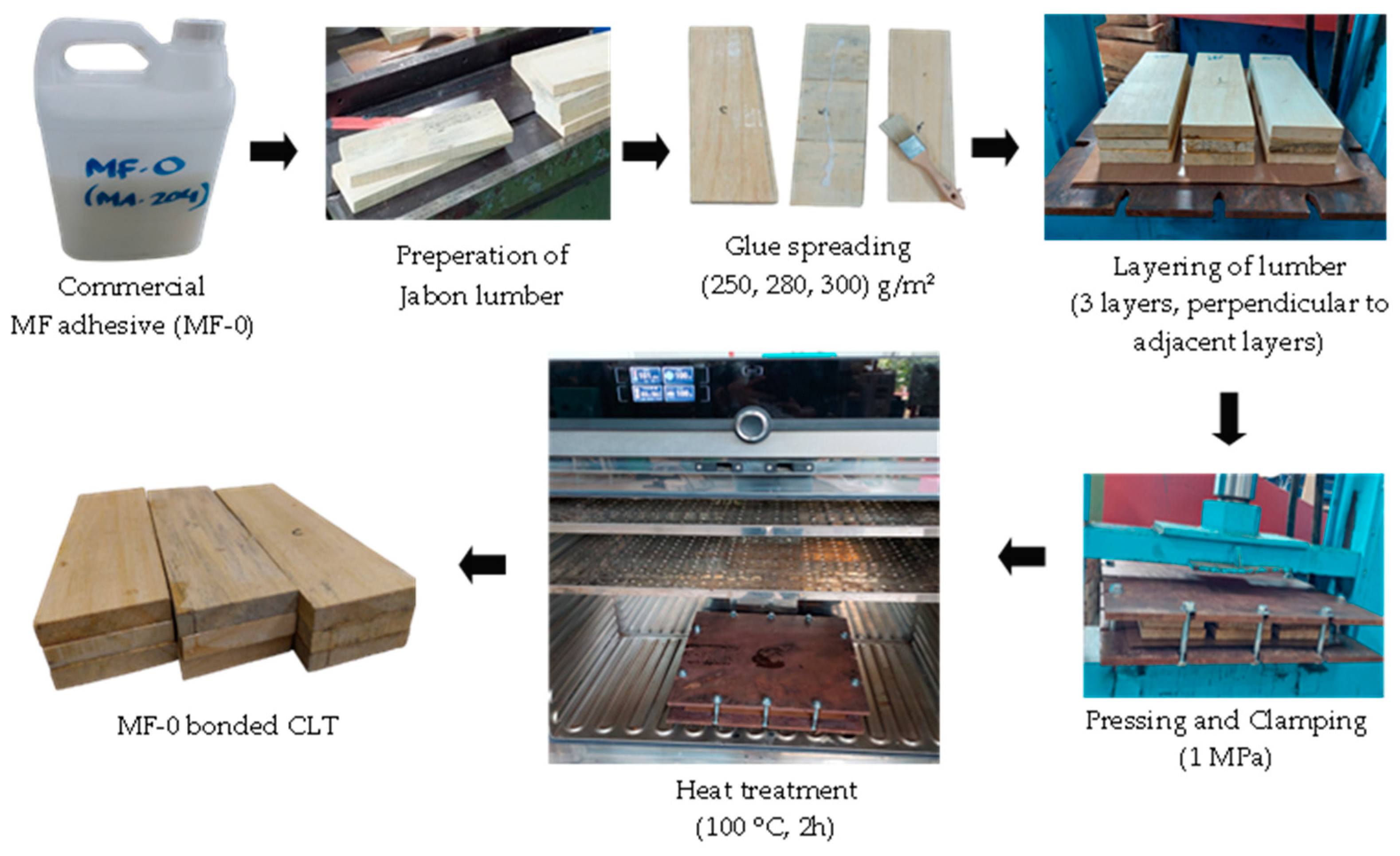


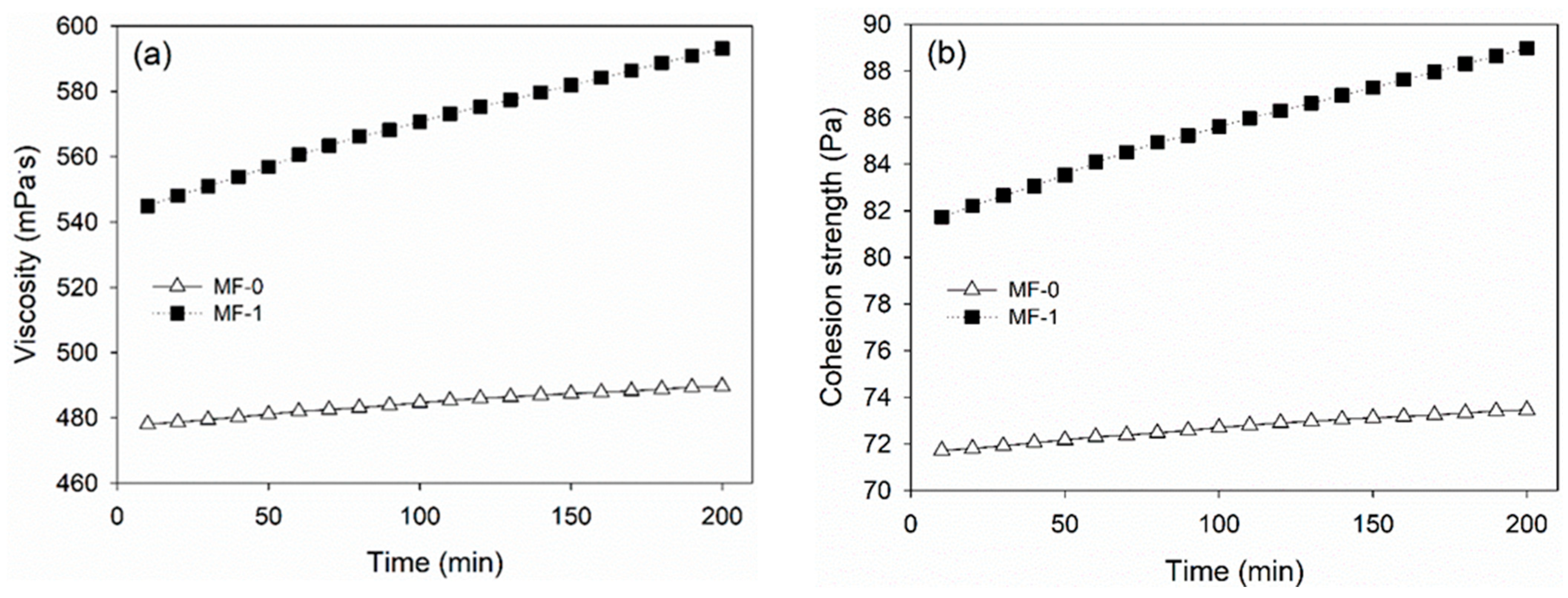
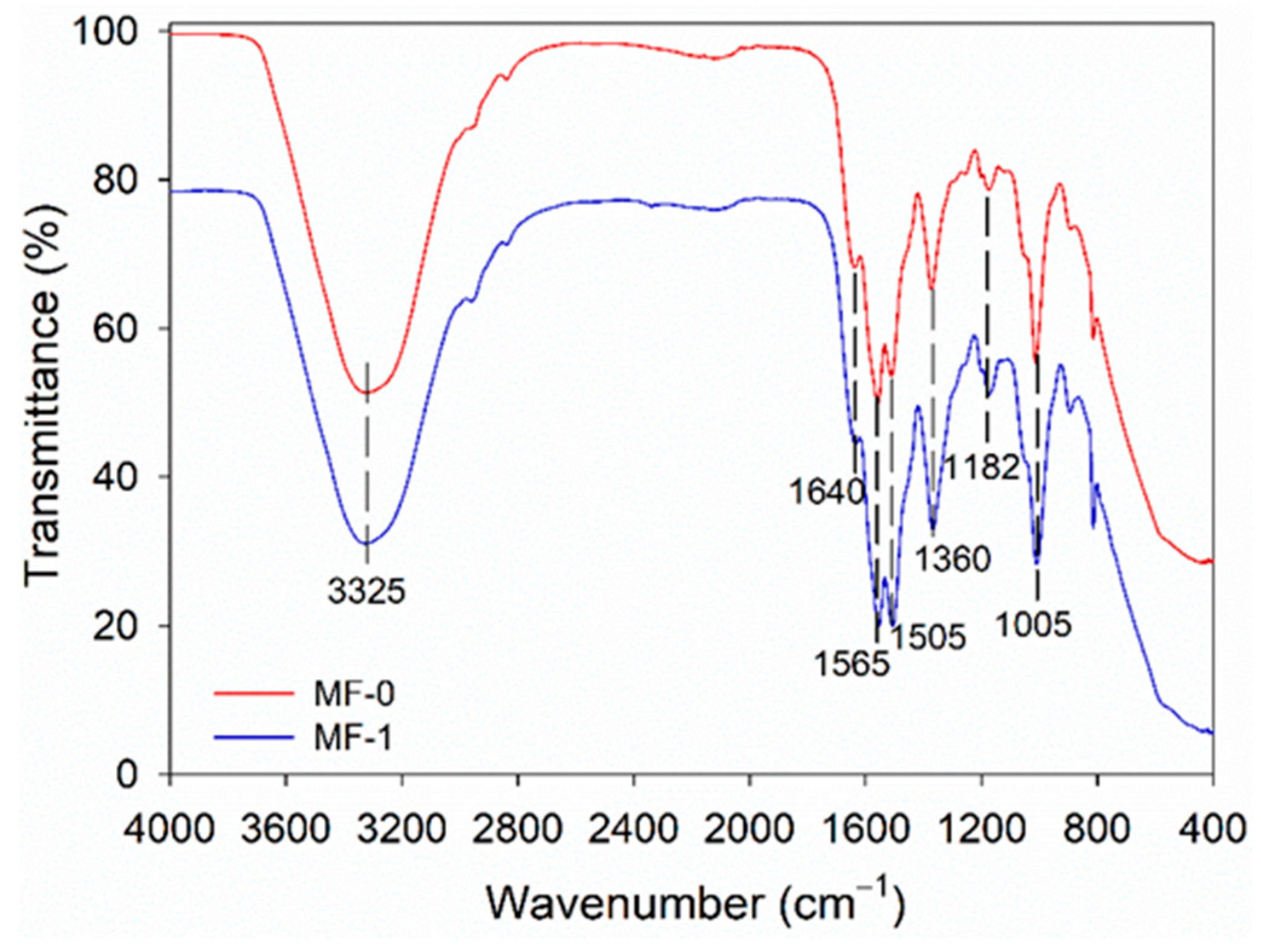

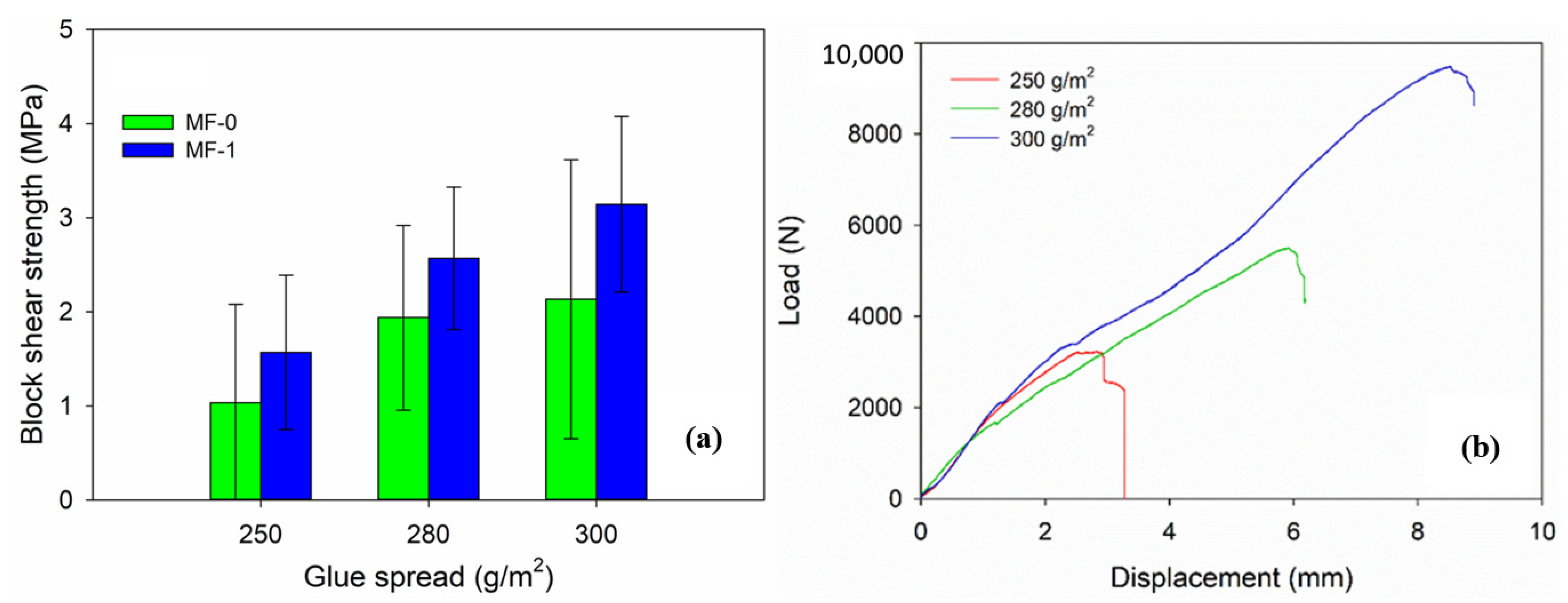

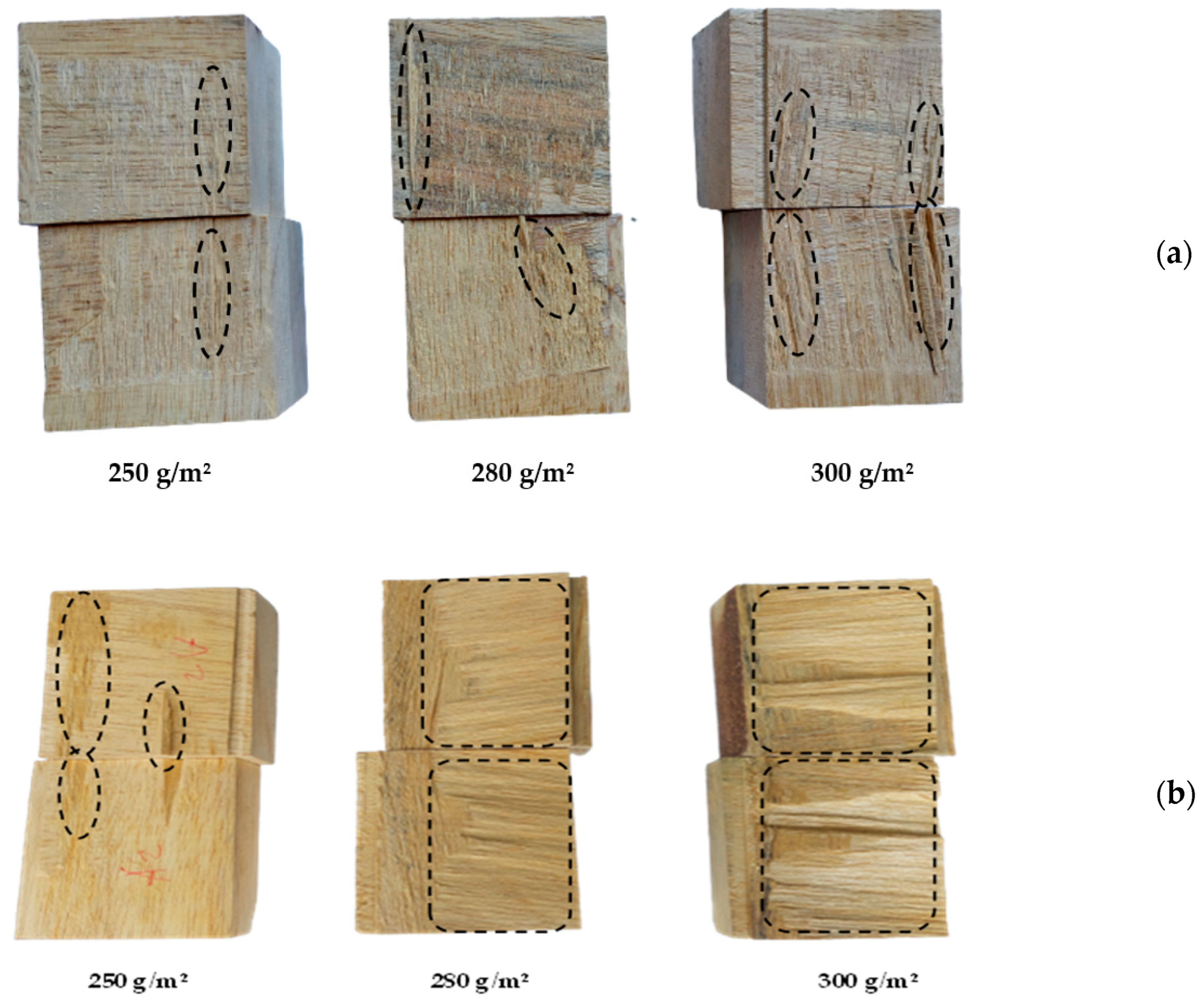
| Type of Adhesive | Properties | |||
|---|---|---|---|---|
| Solids Content (%) | Gelation Time (min, T = 100 °C) | Viscosity (mPa∙s, T = 25 °C) | pH | |
| MF-0 | 51.89 ± 0.36 | 30.27 ± 0.15 | 484.51 ± 3.69 | 7.67 ± 0.58 |
| MF-1 | 48.56 ± 0.08 | 6.90 ± 0.10 | 570.75 ± 14.80 | 6.67 ± 0.58 |
| Properties | SS | Df | MS | F-Value | p-Value | R2 |
|---|---|---|---|---|---|---|
| Bonding strength | 1796.7540 | 1 | 1796.7540 | 6.2785 | 0.0406 | 0.4728 |
| Delamination | 2944.8490 | 1 | 2944.8490 | 24.1056 | 0.0017 | 0.7749 |
| Wood failure | 3317.1950 | 1 | 3317.1950 | 48.0947 | 0.0002 | 0.8729 |
Disclaimer/Publisher’s Note: The statements, opinions and data contained in all publications are solely those of the individual author(s) and contributor(s) and not of MDPI and/or the editor(s). MDPI and/or the editor(s) disclaim responsibility for any injury to people or property resulting from any ideas, methods, instructions or products referred to in the content. |
© 2023 by the authors. Licensee MDPI, Basel, Switzerland. This article is an open access article distributed under the terms and conditions of the Creative Commons Attribution (CC BY) license (https://creativecommons.org/licenses/by/4.0/).
Share and Cite
Amin, Y.; Adji, R.P.; Lubis, M.A.R.; Nugroho, N.; Bahtiar, E.T.; Dwianto, W.; Karlinasari, L. Effect of Glue Spread on Bonding Strength, Delamination, and Wood Failure of Jabon Wood-Based Cross-Laminated Timber Using Cold-Setting Melamine-Based Adhesive. Polymers 2023, 15, 2349. https://doi.org/10.3390/polym15102349
Amin Y, Adji RP, Lubis MAR, Nugroho N, Bahtiar ET, Dwianto W, Karlinasari L. Effect of Glue Spread on Bonding Strength, Delamination, and Wood Failure of Jabon Wood-Based Cross-Laminated Timber Using Cold-Setting Melamine-Based Adhesive. Polymers. 2023; 15(10):2349. https://doi.org/10.3390/polym15102349
Chicago/Turabian StyleAmin, Yusup, Renaldi Purnomo Adji, Muhammad Adly Rahandi Lubis, Naresworo Nugroho, Effendi Tri Bahtiar, Wahyu Dwianto, and Lina Karlinasari. 2023. "Effect of Glue Spread on Bonding Strength, Delamination, and Wood Failure of Jabon Wood-Based Cross-Laminated Timber Using Cold-Setting Melamine-Based Adhesive" Polymers 15, no. 10: 2349. https://doi.org/10.3390/polym15102349
APA StyleAmin, Y., Adji, R. P., Lubis, M. A. R., Nugroho, N., Bahtiar, E. T., Dwianto, W., & Karlinasari, L. (2023). Effect of Glue Spread on Bonding Strength, Delamination, and Wood Failure of Jabon Wood-Based Cross-Laminated Timber Using Cold-Setting Melamine-Based Adhesive. Polymers, 15(10), 2349. https://doi.org/10.3390/polym15102349










